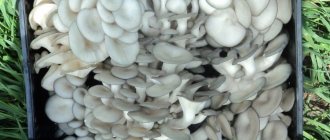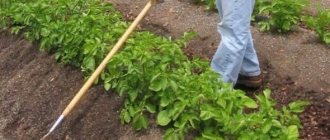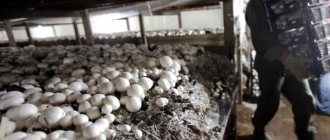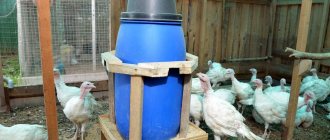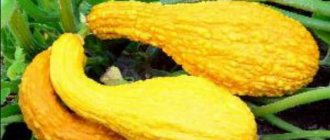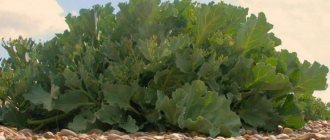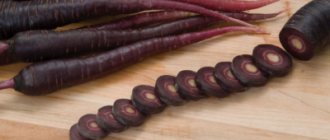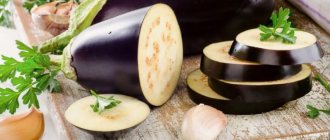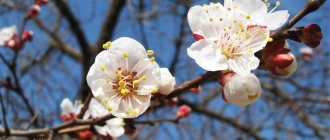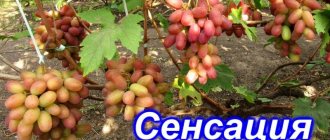Oyster mushrooms are a popular mushroom crop, in demand both among collectors of forest gifts and among housewives who purchase ingredients for culinary masterpieces at markets or in stores. The product we are considering is distinguished by its low price, the rich chemical composition of the fruiting bodies, as well as a bright mushroom taste and persistent aroma - dishes from oyster mushrooms are no worse than dishes prepared using noble white or champignons.
Based on the obvious advantages, they learned to cultivate oyster mushrooms, so you can enjoy mushrooms almost all year round, regardless of the growing season of the mycelium in the wild.
Mushroom farms began to appear in different parts of our country, and the scale of the plantations directly depended on the purpose of cultivation - for home use or for business. Today, even a novice agronomist has heard that cultivating oyster mushrooms does not require huge financial investments, so literally anyone can afford to grow homemade mushrooms.
If you are interested in growing mushrooms at home, stay with us. We will tell you how to grow oyster mushrooms in the basement, spending a minimum of effort and money to get a rich harvest.
Features of culture, benefits
If we consider the description of oyster mushrooms, the exact characteristics of the fruiting bodies will look like this:
- Mushrooms resemble umbrellas with sweeping caps of white or beige-gray color; as a rule, they grow in “families.” The average diameter of the mushroom is 5-20 centimeters.
- The ideal substrate for the plant is fallen deciduous trees and dead stumps.
- The growing season in the natural environment is from the beginning of September to the end of November (depending on the climate of the region). If we talk about growing mushrooms on artificially created plantations, the harvest can be harvested all year round.
- The pulp of the fruiting body contains large amounts of protein, iron, calcium, vitamins C, BB, P, as well as phosphorus, amino acids, zinc, magnesium and iodine, which makes the product valuable not only for cooking, but also for medicine.
Despite their high nutritional value, oyster mushrooms are low in calories, which means they are suitable for those who adhere to various diets, including vegetarians. Mushroom pulp is an excellent natural antibacterial and antitumor agent, helps with pressure surges, and improves immunity. Like any other product, oyster mushrooms should be consumed with caution. Uncontrolled overeating of delicacies can lead to poisoning, as well as problems with the gastrointestinal tract (since any mushroom is considered a difficult-to-digest food).
Typical mistakes when growing mycelium
If you do not maintain the required temperature in the basement, mold will appear on the oyster mushroom.
If, when growing mushrooms, you observe weak fluffing of the mycelium, and the ripening time has increased significantly, then the most likely reason for this lies in non-compliance with the optimal temperature regime necessary for the correct formation of the mycelium. To fix the problem, you will need to adjust the temperature in your basement.
Sometimes weak frizz is also accompanied by the appearance of dark or green spots on the surface of the block. The reason for this is dirt introduced during preparation of the substrate or during inoculation. Remember that growing mushrooms requires strict sanitary standards.
Another reason for the appearance of such stains can be mold. In any case, it is not worth risking the entire harvest. Isolate the affected unit from the rest and thoroughly sanitize the basement. It is possible that mold will not have a significant effect on the crop. But it's not worth the risk.
Mold can cause the appearance of numerous colonies of fluffy mycelium both in open areas of the substrate and on the fruiting bodies themselves. In this case, the affected oyster mushrooms turn yellow, lose their elasticity and become watery. Such lesions are caused by the fungus Arthrobotrys pleuroti. In this case, the mushroom block must be completely destroyed along with the harvest, and the basement must be thoroughly treated using disinfectants.
Preparing the conditions necessary for the development of the fungus
Speaking about the natural habitat, the forest gifts we are considering can be found after the heat, before frost. The optimal temperature for mycelium growth is 15-27 degrees Celsius, humidity is 70-80 percent. If the crop is grown on a plantation, it is important that temperature fluctuations do not exceed 2 degrees in both directions. The farm must also be equipped with lighting, climate control systems and good ventilation.
First of all, it is important to choose the right room - oyster mushrooms grow best in the basement. In the absence of one, some agronomists place plantations in cellars or barns.
The floor surface must be concreted, since it is strictly prohibited for foreign microorganisms to enter the mycelium. So, the preparatory stage includes the following activities:
- Search for premises;
- Surface disinfection;
- Installation of the necessary equipment (ventilation systems, electrical networks, irrigation systems, etc.).
Remember that your farm must meet certain requirements. The air temperature should be unshakable, as should the humidity, and the surfaces of the walls and floors should be sterile (whitening the walls with lime is practiced). If necessary, turn on the lighting and ventilate the basement.
At the same time, you can begin manufacturing or purchasing mycelium with substrate from the manufacturer. Next, we will tell you how to make the above-mentioned “ingredients” yourself.
Substrate procurement and processing
First, you need to buy mycelium and a substrate on which oyster mushrooms will grow. Suitable substrates include dried stems, hay, buckwheat and seed husks, and shavings from hardwood. The main requirement for the substrate is the complete absence of mold and rot.
Self-collection of the substrate is quite a difficult task. All beginners are recommended to purchase ready-made material, packaged in thick plastic bags. When purchasing, pay attention to its composition. It is important that it is suitable for growing oyster mushrooms.
Substrate processing can be carried out in the following ways:
- hydrothermy (use of hot water);
- pasteurization (blowing steam over a moistened substrate);
- xerothermy (blowing steam onto dry material).
The purpose of this treatment is to make the substrate looser, fill it with oxygen and other useful substances. The root system of fungi will develop in comfortable conditions protected from fungus. This will speed up the cultivation of oyster mushrooms and allow you to harvest several large harvests per year.
To prevent mold from forming, dry the substrate thoroughly after washing. To do this, leave it to dry in a warm place for 2 days. During this time, all excess liquid will drain.
After this, the available raw materials are crushed and mixed. This will help the substrate retain water better. The resulting material is completely ready for planting oyster mushrooms.
Oyster mushroom grain mycelium.
If you decide to purchase the vegetative body of a mushroom, that is, the so-called “mycelium,” carefully choose a supplier. To get started, purchase a small trial batch. Be sure to check the information on the supplier's certificate and labels. The most important points for you are the speed of germination, resistance to diseases and fungi, variety and shelf life.
The mycelium should not have an ammonia smell, nor black or gray spots (this may indicate incipient mold). It should have an orange or yellow tint.
It is very important to find out whether all storage conditions have been met. Oyster mushroom mycelium should be stored at a temperature of +3-4°C in the basement or refrigerator. The temperature during transportation should not exceed 20°C. If these conditions are met, its shelf life is 6-9 months depending on the variety.
After you purchase mycelium in bags, leave it at room temperature for 1 day. Then stack them separately from each other so that they can freely access air. Keep in mind that the shelf life of the house is significantly reduced, so you should start planting as soon as possible.
Before storing, carefully chop the mycelium without opening the bag. After this, briefly transfer the bags to the room with the substrate, that is, to the basement. This is necessary so that the temperature equalizes and the mycelium does not die from shock.
Opening the package with mycelium should be done exclusively in a clean room. Use gloves and disinfect the table with an alcohol solution. It is worth noting that growing oyster mushrooms and planting mycelium should be carried out in different places to avoid infection of the mycelium. If you don't have a separate room, use a room divider to separate a small space in your basement.
Obtaining mycelium
As we noted earlier, anyone can purchase mushroom mycelium without spending time and effort on its production. However, there are also disadvantages to purchasing the material:
- Additional financial expense;
- Lack of confidence that the acquired mycelium is of the highest quality, which directly affects the yield.
That is why we will tell you how to get mycelium with your own hands.
- You will need whole, fresh oyster mushrooms or their fragments. Mushrooms are cleaned of germs and foreign microorganisms using ordinary hydrogen peroxide.
- After processing, the stage of transferring the sterile raw material into a test tube follows, in which the mycelium will further develop. It is important to carry out manipulations over a fire flame - this eliminates contamination by irritants from the environment.
- The mycelium is kept in a nutrient medium (optimally potato or oat agar) for 15-20 days. The room should be dark and warm (+23-24 degrees).
After the specified time, the mycelium can be planted in the substrate.
For information! There are several dozen varieties of oyster mushrooms found in nature, but only a few of them are commonly cultivated: oyster, common, pink, K-12/NK-35/R-20.
The listed representatives are edible and are characterized by high yields, which is beneficial for those who decide to engage in agricultural business.
How to plant
The planting technology is as follows:
- Transfer the mycelium to the basement where the mushrooms will be grown. This will allow the acclimatization process to take place.
- Carry out the process of disinfecting wood by treating it with copper sulfate (50 g per 10 liters of water).
- Make 5 cm indentations in the logs, which should be staggered. The distance between them should be 20 cm.
- Pour the prepared substrate inside.
- Place the mycelium at a distance of 1 cm from the edge of the depression and cover it with compost.
- Pour warm water over it. 100 ml is poured into each hole.
Substrate production
If you decide not to purchase a substrate, but to make it yourself, follow the step-by-step instructions below:
- Decide on the raw materials on which your crop will grow. The practice of experienced farmers shows that oyster mushrooms develop best in straw, sawdust, sunflower husks or corn cobs.
- Prepare the material by chopping it into equal fragments (the optimal size is 4-5 centimeters).
- Place the resulting mass in a large cooking container (for example, a tank), fill with cold, clean water. The ideal ratio of liquid to raw materials is 2:1.
- Boil the future substrate for 2-3 hours, drain the water and wait until the excess liquid drains and the base cools to room temperature.
After completing the last stage, the substrate is ready for laying.
Germination conditions
Oyster mushrooms grow under certain conditions:
- Constant temperature ranging from 17 to 28°C. Allowable temperature fluctuations are no more than 1-2°C. With more significant differences, the mycelium may die.
- Humidity over 50%. Optimal humidity levels for mushroom growth are 70-90%.
- Illumination. At a certain stage, the mycelium requires access to light. Therefore, you need to install a lighting system in the basement.
- Ventilation.
Access to fresh air is provided by a ventilation system or by ventilating the basement.
Popular growing methods
Even before purchasing a substrate with mycelium, the mushroom grower needs to choose the method by which he plans to obtain a mushroom harvest.
Oyster mushrooms can be grown:
- On tree stumps;
- In bags;
- Using containers (plastic bottles, boxes, bags).
Article on the topic - Growing oyster mushrooms on stumps.
The most convenient means at hand are bags, that is, polyethylene bags. They can not only be placed on shelves, but also hung on the walls.
Let's move on to the direct process of growing the fruits of the crop:
- Form mushroom beds or so-called blocks. If we consider the use of bags, the main actions of the agronomist are to fill a large bag with substrate and mycelium in layers. It is important that the bottom and top layer be a substrate; the mycelium should not be openly on the surface. The ideal ratio of material is 5 cm, alternating layers.
- “Install” the blocks as they will be located throughout the growing season. Cut thin holes in the walls (at a distance of 10-15 centimeters from each other). If we are talking about growing on stumps, everything needs to be done on wood.
- Maintain favorable conditions for the culture - air temperature 21-26 degrees Celsius, humidity about 90 percent. Lighting and ventilation will not be needed at this stage. Incubation lasts approximately 2 weeks.
One type of bookmark
Climate
Monitor the process carefully. You will be able to understand that you are on the right track if, after two days, you find a white coating on the surface of the substrate, reminiscent of fine fluff. When the entire block is covered with overgrown mycelium, the incubation period “transforms” into actively growing mushrooms. This stage involves changing the conditions of the farm, namely:
- The air temperature should be reduced to 16-19 degrees.
- The ideal humidity percentage range is from 83 to 90.
- Developing fruiting bodies should receive a “dose” of light that simulates daylight hours - approximately 12 hours a day.
Recommendation
It is also very important to get rid of accumulated carbon dioxide by constantly ventilating the room. Is the soil drying out? Don't forget to spray the blocks with liquid.
Basement preparation
So, what should be in the basement in which oyster mushrooms and shiitake are grown?
1.
Stable temperature from 10 to 20°C.
2.
Air humidity is from 85 to 90%.
3.
Sophisticated ventilation system.
4.
Free from mold and pests.
5.
Purity.
If, after studying the list, you find any problems, be sure to fix them. It is recommended to start preparation with cleaning. It will allow you to find the sources of problems and free up space for shelving and equipment.
To achieve the required temperature, you need to make the room airtight and think through the heating system. Typically, to warm the basement you need to insulate the floor and walls. After this, you will only need one heater, which must be turned on once a day.
Mold in the basement for growing vegetables can be a serious obstacle to a rich harvest. Fight it by warming up the room, regular cleaning and coating the walls with special antifungal paint.
At the slightest suspicion of pests, call a professional or carry out pest control yourself. It is most convenient to use a smoke bomb and industrial insecticides. Remember that after treatment, at least 1 week must pass before laying the blocks with the substrate.
The last step in preparing the basement is thorough cleaning and disinfection. It is carried out using a 1% chlorine solution or bleach. Please note that in addition to the basement, you will need a separate, warmer room for incubating oyster mushrooms.
How to collect oyster mushrooms in the basement
With the correct sequence of actions, an agronomist can get the first harvest of mushrooms within 5-6 weeks after planting the crop. On average, 1 kilogram of mycelium accounts for 2.5-3 kilograms of delicacy. It is important to cut the fruiting bodies correctly - at the very base, but so as not to damage the mycelium. The fact is that oyster mushrooms ripen in waves, and after the first harvest, a second one follows almost immediately. The second wave brings 25-30 percent fewer mushrooms than the first.
Experienced mushroom growers prefer not to pay attention to the third wave, sowing new blocks, since they account for no more than 30 percent of the harvest.
If you haven't thought through where you will store the collected fruits, free up space in the refrigerator. The shelf life of fresh oyster mushrooms is no more than 5 days. In the presence of industrial refrigeration chambers and special storage containers, the time period is extended to 14-18 days.
We looked at how to grow oyster mushrooms in the basement, regardless of what goal the “farmer” is pursuing. Strict adherence to the advice and high-quality material will provide you with a rich harvest of tasty, healthy product.
Growing and collecting mushrooms
When good growth of the mycelium is noticeable to the naked eye, cuts are made in the bag crosswise (the length of the cuts is approximately 2.5 cm). One mushroom block requires approximately 11 holes. During this period, it is best to place the mushroom blocks approximately 10-30 cm above the floor level. This way, carbon dioxide and pests accumulating below will not reach the oyster mushrooms.
When mushrooms form, abundant watering is necessary. It is best to carry it out using a spray bottle. To supply water inside the bag, you can punch additional holes in the block or water through the slots already made for the growth of oyster mushrooms.
The main sign of a ripe mushroom is the formed hymenial plate.
The best way to humidify the air to effectively grow oyster mushrooms is to use a high-pressure diffuser at the beginning of the air duct into the basement. In winter, if possible, use steam. You can also increase the humidity inside the room by watering the floor, but you should not abuse this method.
The main sign of a ripe mushroom is the formed and elastic hymenial plate (the inner side of the cap). In this case, the edge of the oyster mushroom should still be bent down. When the edge is straightened, spores are released and the mushroom loses weight. Therefore, it is worth harvesting a little ahead of time.
When picking mushrooms, you need to pull them out of the substrate, and not cut them off. Leg sections are an ideal place for green mold (Trichoderma) to develop.
You can grow up to 4 shoots on one block. As a rule, the 2nd shoot is the largest. But after the 4th harvest, the substrate should be completely changed, even if the mushrooms continue to grow. Along with the fungi, pathogenic microorganisms also multiply and can infect the entire basement.
Be sure to carry out all work wearing protective glasses, a mask and gloves. Taking these precautions will help protect not only your oyster mushrooms, but also your health.
Basics of growing technology
The entire technology for growing oyster mushrooms can be divided into 4 stages. The first involves processing the substrate. Methods for processing it are given in the previous part of the article. The easiest way to prepare it for use at home is with hot water. Add water so that it completely covers the substrate and boil for 1.5 hours.
Pre-boiling the substrate.
Many people prefer to boil the substrate directly in plastic bags. In this case, you need to make several holes in them so that water can circulate smoothly. After draining the water, it is advisable to place the substrate under a press and leave it for a day to remove all excess liquid.
The planting of oyster mushroom mycelium should be carried out only in sanitary conditions. Pre-disinfect the basement, treat the bags with an alcohol solution and wear gloves. If there is ventilation in the room, it must be temporarily blocked to prevent the spread of fungus. Also wash the work surface with a disinfectant and water.
Pour the mycelium and substrate onto the table, mix them, taking into account that the total mass of the substrate should account for 3% of mycelium from domestic manufacturers and 1.5-2% of mycelium from foreign manufacturers.
Place the resulting mixture into special 10-15 kg bags and compact tightly. If you are trying to grow oyster mushrooms in the basement for the first time, use 5 kg bags. The smaller the volume, the easier it is to regulate the temperature inside the block.
Bags with substrate for mushrooms.
When you have packaged all the available mixture, slightly flatten the bags on one side and apply perforations on the other. The cuts are made with a sharpened and clean knife at an angle of 45°. The length of each cut should be 50 mm.
The compacted bags are transferred to the incubation room, where the average temperature is +25°C. They are placed on racks so that the perforated sides have free access to air. In addition, there should be free space between the bags. It must be at least 5 cm. It is prohibited to place them on top of each other. Now the 3rd stage begins - incubation.
Incorporation of mycelium into the substrate.
Convenient racks for oyster mushrooms
The use of racks for growing oyster mushrooms allows, first of all, to facilitate the ventilation of mushroom blocks. The crop can suffer from an excess of carbon dioxide, which is why ventilation is so important. Mushrooms planted in a poorly ventilated basement, cellar or garage basement are in danger of dying.
But there are a number of other reasons to use shelving:
- Cleanliness of the room. It is very important to maintain cleanliness in a basement or cellar adapted for growing mushrooms. The rack makes this task easier; it is ergonomic.
- It is convenient to place irrigation hoses between the racks.
- The racks themselves can be made with your own hands, from scrap materials.
It is better to make racks from metal, ideally with an aluminum profile. Shelves can be made in the form of trays in which mushroom blocks can be placed, or flat with pins located between them for hanging bags.
Having decided to grow mushrooms yourself, it is important to decide what goals to pursue. It’s up to the enthusiast to decide whether he wants to satisfy his own and his family’s needs for champignons and oyster mushrooms or make money by growing a tasty and healthy agricultural product.
